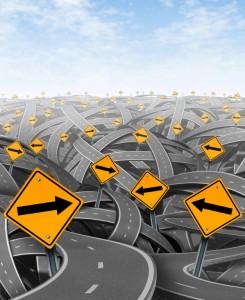Brain Networks – Part 2

Everything is networked.
Yesterday (and in earlier articles here and here), we talked about two brain networks – default and reward – and their implications for organizational behavior. Today, let’s take on two more networks – affect and control – and see how they work in the office. Again, I’ll draw on a recent HBR article by Adam Waytz and Malia Mason.
The affect network activates when people experience emotions. You might think that we consciously recognize something and then feel some emotion about it. That’s true sometimes but often it’s the other way round, with the affect network leading the way. You see a snake and your pulse quickens. Your brain interprets this as fear. Your body – not your brain — reacts to the external stimulus. Your brain reacts to your body’s reaction. (Conceptually, this is similar to System 1 vs. System 2, and thinking with your body).
How does this effect behavior at the office? Well, did your gut ever tell you something? As Waytz and Mason point out, “A hunch is not some mystical sixth sense. It’s a real neurological response that manifests itself physically”. In other words, your affect network is telling you something based on what your body is telling the affect network.
I used to think that I should rationally analyze every key decision and generally ignore my gut feel. Gut feel was irrational and emotional; better to use logic and reason. But Waytz and Mason point out that, “…a mounting body of neurological evidence suggests that emotional impulses should not be ignored. The affect network fast-tracks decision making and helps us process information that may include too many variables.” It’s not obvious how your gut feel reaches your conscious mind, but it often gets there for a good reason. Don’t ignore it.
Finally, there’s the control network that helps people focus their attention and rationally consider long-term decisions. As I understand it, it seems very similar to what Daniel Kahneman calls System 2. The control network “… aligns our brain activity and our behavior with our goals.”
The control network is at the opposite end of the spectrum from the default network. Where the default network activates when you unhook, the control network hooks in and manages all the other networks. The more your have of one, the less you have of the other – similar to focus and creativity.
The control network is rational and also helps us ration our resources. In particular, it rations our attention and helps us focus on those things that are most important to achieving our goals. If you’re like most people, there’s a lot of stuff competing for your attention. As Waytz and Mason put it the control network has “…a tricky attention-management challenge…. On one hand, it needs to prevent distractions from every shiny object thrown in front of us. On the other hand, it needs to let us respond when one of those shiny objects is an opportunity or an important demand”.
The control network has a tough job and can easily get overloaded if there are too many bright shiny objects. This reinforces some traditional wisdom: to execute effectively, organizations should limit their goals to a “manageable few”. It also suggests that we should beware of multitasking. Pursuing multiple tasks at once simply overloads the control network and makes effective rationing impossible. As the authors point out, “Success as a leader requires, first and foremost, creating just a few clear priorities and gathering the courage to eliminate or outsource less important tasks and goals”.
What does all this mean? Well, it’s goes back to what your mother taught you. First, when your emotions tell you something, there’s usually a reason. Second, do only a few things but do them well. It’s nice the neuroscience backs up dear old Mom.
Brain Networks At The Office

Quick! Activate the default network!
When you’re “zoned out”, your brain’s default network kicks in and processes stuff. What kind of stuff? Well, not new stuff because you’re zoned out and no new stuff is coming in. You’ve unhooked yourself from the grid and the only thing your brain can work on is stuff that’s already in your brain. It’s like mentally chewing your cud.
It turns out the default network contributes in very important ways to creativity. As Adam Waytz and Malia Mason point out in a recent issue of Harvard Business Review, the default network is “… responsible for one of our most prized abilities: transcendence. The capacity to envision what it’s like to be in a different place, a different time, a different person’s head, or a different world altogether is unique to humans….”
To create creative environments, managers are beginning to realize the importance of allowing employees to “unhook” and activate their default networks. Unfocused free time is critical to creative thinking and innovation. As I’ve pointed out before, too much focus can kill creativity. Waytz and Mason point out that many of the “creative time off” programs at companies like Google may still miss the mark. They focus on quantity of time off, rather than quality. The authors argue that it may be better to focus on “total detachment” rather than the number of days off. The idea is to “unfocus” and activate the default network rather than to shift focus to a project of personal interest.
In addition to the default network, Waytz and Mason identify three other brain networks that can contribute to improved performance and productivity. These are: the reward network, the affect network, and the control network. Let’s look at the reward network today. We’ll visit the affect and control networks tomorrow.
Waytz and Mason compare the reward network to a hedonometer, a hypothetical instrument that could “…measure the amount of pleasure or displeasure we feel in response to any stimulus”. The reward network “…reliably activates in response to things that evoke enjoyment and deactivates in response to things that reduce enjoyment”.
In animals, the reward network activates when the animal encounters something– like food or water — that has clear survival value. The same is true of humans. But there’s more to the human reward system. Unlike animals, the human reward system activates for “secondary” rewards – those that have no direct survival value.
Money is clearly an important secondary reward, but numerous, non-monetary secondary rewards also exist. Some are obvious, like status and recognition. Others are less obvious, like fairness. Waytz and Mason argue that employees’ reward systems light up when they perceive their organization to be fair. When the organization is perceived to be unfair, the reward system dims and employees lose motivation. This is true both for employees who benefit from the unfairness and for those who suffer from it. As Waytz and Mason put it, “A fair environment is a reward to people regardless of their standing”.
So how do you fine tune the reward system? Both fairness and transparency are important. Somewhat surprisingly, so is the expectation of learning. When employees expect that they will learn something, the reward system activates and motivation rises. Goals are also important but Waytz and Mason argue that broad goals that provide employees some room to maneuver activate the reward network more effectively than narrowly defined, overly stringent goals that leave little room for judgment.
And what about money? Well, it can be useful. But Waytz and Mason conclude that, “Any number of things employers can do ‘on the cheap’—fostering a culture of fairness and cooperation, offering opportunities for people to engage their curiosity, and providing plenty of social approval—will motivate employees as much if not more [than money]”. So think about money in your reward structure … but not too much.
Will Social Media Make You Crazy?

This person has been edited.
Social media has been getting a bad rap in the press recently. First, there’s The Innovation of Loneliness, a terrific short film (just over four minutes) by Shimi Cohen. It suggests that one of the key differences between real life and social-media life is the ability to edit. We can edit ourselves on social media and put our best foot forward. Not so in real life and, according to Cohen, that’s what makes real-life superior. Simply put: you interact with real people, not edited people.
Cohen — whose film is based on Sherry Turkle’s book Alone Together – urges us to slow down and have actual conversations with others. He also explains (though never names) the concept of Dunbar’s Number – that humans naturally organize themselves into groups of 150 or less. He implies that any group larger than 150 is too much for the human mind to handle. So what’s the point of having, say, 500 friends on Facebook?
Cohen’s film reminded me of the many articles I’ve read on mindfulness recently. For instance, Scientific American Mind recently led with mindfulness as its cover story. I’ve also been reading Mindfulness for Beginners by Jon Kabat-Zinn. The common thread is the admonition to slow down and, as Kabat-Zinn phrases it, “reclaim the present moment.” These writings don’t specifically suggest that social media is bad for you but it’s an easy conclusion to draw.
A research article recently published in the Public Library of Science (PLoS) is much more specific. In fact, its title pretty much says it all: “Facebook Use Predicts Declines in Subjective Well-Being Among Young Adults”. (The original research paper is here. For non-technical summaries, click here for an article from The Economist or here for one from the L.A. Times).
The study tracked 82 young people as they used Facebook. They were also asked to report their “satisfaction with life” at the beginning and end of the study. Bottom line: “…the more they used Facebook [during the study period], the more their life satisfaction levels declined over time.”
The PLoS study doesn’t identify the causes in decline of life satisfaction. But The Economist points to an earlier study to identify a likely culprit. The study, conducted in Germany, found that “…the most common emotion aroused by using Facebook is envy”. The Economist makes essentially the same point that Shimi Cohen does:
Endlessly comparing themselves with peers who have doctored their photographs, amplified their achievements and plagiarised their bons mots can leave Facebook’s users more than a little green-eyed. Real-life encounters, by contrast, are more WYSIWYG (what you see is what you get).
So should we drop social media? As I wrote several months ago, I still think it’s a good way to stay in touch with our “Christmas card friends” – those friends whom we like but don’t see very often. For our bosom buddies, on the other hand, it’s probably better to just slow down and have a nice, mindful heart-to-heart conversation.
Understanding the Railroad Cliché

Tax collector.
It’s become a cliché that the problem with railroad companies is that they defined themselves as railroad companies. When other forms of transportation came along, railroad executives missed the opportunity to become multi-modal transportation companies. They boxed themselves out of the next growth industry.
I’ve often heard executives mention railroads as a cautionary tale: don’t define your business too narrowly. Indeed, the idea has become a meme that seems to live independently of us. Like a virus, it simply replicates and spreads.
I didn’t know where this particular meme came from, so I decided to track it down. By tracing where the insight came from and how it developed, I thought I could learn more about how to avoid disruption.
I found the originating article fairly quickly: “Marketing Myopia” by Theodore Levitt published in Harvard Business Review in 1960. I’m sure I’ve read the article before but I don’t remember when. The meme simply planted itself in my head and lived on without further cultivation.
What else did Levitt have to say? Essentially that businesses exist to solve problems for their customers. Too many businesses become enamored of their technology and their production processes and put the customer at the end of the chain rather than at the beginning.
Levitt uses the petroleum industry as a running example of the problem. As he saw it, oil companies define themselves as oil companies, not as energy companies. They focus on finding, extracting, and refining oil and don’t really understand their customers’ issues.
Levitt points out that people don’t like buying gasoline. It’s an interruption and an inconvenience and how can you really tell if you’re getting good gas or not? He writes, “What [people] buy is the right to continue driving their cars. The gas station is like a tax collector….” Levitt predicted that a new technology – probably fuel cells – would soon make it easier to continue driving our cars and that oil companies would be in dire straits.
Levitt also warned that technical research would not protect companies from obsolescence. Technical research tends to focus on improving something that already exists. The issue is that something that doesn’t exist comes along to disrupt existing industries. Fall in love with your technology and you’ll be blinded to the threat.
Similarly, mass production is like a drug. Too many executives believe that they can solve most any problem by scaling up and reducing unit costs. But that simply lowers the cost of something that customers don’t want.
As Levitt writes, it’s ultimately about the customer, “Selling focuses on the needs of the seller, marketing on the needs of the buyer.” Rather than focusing on technology, products, and production, a marketing-oriented company focuses on “satisfying the needs of the customer by means of the product and the whole cluster of things associated with creating, delivering, and, finally, consuming it.”
Ultimately, marketing is not about making the product attractive to the customers. It’s about making products that attract customers. When we use the railroad cliché, we sometimes forget that. We may think about definitions and imagination. But it’s really about understanding and it begins with the customer.
Are You Happy? Hedonic or Eudaemonic?

Eudaemonia!
Research on happiness often distinguishes between two types: affective happiness and evaluative happiness. Affective happiness is how you’re feeling now and in the recent past. It’s fairly volatile and can rise or fall quickly. Evaluative happiness measures how happy you are with your life. It tends to be more stable.
Both types of happiness fit into a broader category generally known as the hedonic theory of happiness. This is essentially the pleasure principle – we seek pleasure and avoid pain. It’s fairly straightforward and is often considered the ultimate goal in theories of positive thinking.
But let’s think critically about this. Is pleasure really all there is to happiness? When you overcome obstacles in life, doesn’t that make you happy, even if the process is painful? Can you be happy simply by thinking positively and banishing negative thoughts? Indeed, can you truly banish negative thoughts and emotions?
These questions lead to a different theory of happiness that’s often known as the eudaemonic perspective. In Western thought, the concept originated with Aristotle. The basic idea is that we should lead an actively engaged life, colored by virtue and excellent character. It’s often compared to what Mihaly Csikszentmihalyi calls flow – when you’re completely immersed in what you’re doing. You harness your emotions toward a task and become completely absorbed by it.
When you’re fully engaged, negative thoughts may arise just as easily as positive thoughts. Rather than trying to suppress negative thoughts, you simply let them flow by. They’re part of who we are. In fact, they probably have some survival value. They can spur you to take action against an obstacle, do something unpleasant but necessary, or even just take your medicine.
Indeed, it may well be the case that trying to suppress negative thoughts causes us to have more of them rather than fewer. As Tori Rodriguez reports, a phenomenon called dream rebound may come into play. Researchers at the University of New South Wales divided participants into two groups. One group was asked to suppress a negative thought just before falling asleep. The other group did not try to suppress their thoughts. Those who tried to suppress their negative thoughts reported dreaming about it more frequently than those who didn’t. (Though it’s a different realm, this is similar to Jevon’s paradox).
In my experience, negative thinking produces a second-order effect. First, we have a negative thought. Second, we get wound up about having negative thoughts. OMG, am I a negative person? Why do I have such negativity?
In my opinion, the second-order effect is more damaging than the first. Of course we’re going to have negative thoughts. We can’t avoid them. In fact, they probably help us survive. The trick is to let them pass. As the Tibetans say, thinking is like writing on water. It goes away. Allowing negative thoughts to flow may not lead us to hedonic happiness but may very well stimulate eudaemonic happiness.